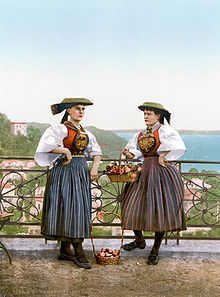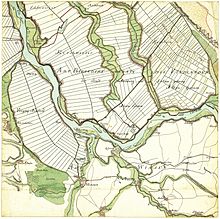Vierlande
| Location of the Vierlande
in Hamburg |
|
|---|---|
| Basic data Vierlande | |
| State : | Germany |
| State : | Hamburg |
| District : | Hamburg-Bergedorf |
The Vierlande is an area of around 77 square kilometers in the Hamburg district of Bergedorf with 18,419 inhabitants, consisting of the four districts of Altengamme , Curslack , Kirchwerder and Neuengamme . When Vehrlande was first mentioned in the Bergedorfer Treasure Register from 1548, the name denotes four parishes or originally four river islands in the glacial valley of the Elbe , which are largely identical to today's districts.
The Vierlande are often named together with the neighboring Marschlanden (" Vier- und Marschlande "), with which they formed a joint local office within the Bergedorf district until 2008 . In contrast to the Vierlanden, the Marschlande had been part of Hamburg since the end of the 14th century.
history

Altengamme is mentioned for the first time in 1188, Neuengamme ("New Land") and Kirchwerder in 1212, Curslack in 1217.

The inhabitants of the Vierlande were free farmers, but rule over the area changed several times: From the 12th century it belonged to the Dukes of Saxony-Lauenburg , who pledged it to the Hanseatic cities of Hamburg and Lübeck due to lack of money and in 1401 forcibly without repayment of the pledge repossessed. In 1420 the two cities recaptured the Vierlande together with Bergedorf and the Riepenburg and then managed it jointly until 1868 ( condominium ). Since then, the area has belonged to Hamburg alone and was part of the Bergedorf estate ; only a part of Kirchwerder remained an exclave of the Prussian district of Harburg until the Greater Hamburg Act came into force in 1938 .
Dyke construction
The first dikes were made in the course of reclamation in the 12th century. In the 14th century, Hamburg began to seal off the Gose Elbe and Dove Elbe in order to protect the Vierlande from the regular floods. The course of the Elbe was straightened and more water flowed through the Norderelbe . This made it easier for seagoing ships to call at the port of Hamburg, while the port of Harburg on the southern Elbe was increasingly silted up. This promptly led to a conflict with the Principality of Lüneburg that lasted for several centuries. For example, in 1620 soldiers of the Brunswick-Lüneburg dukes attacked the Kirchwerder parish and removed a freshly created dike. However, the course of the Elbe remained in the newly created bed, so that this action was unsuccessful.
Growing flowers and vegetables
Agriculture began in the 17th and 18th centuries with the cultivation of barley and hops . Flowers, fruits and vegetables are grown today. The Vierland farmers have always sold their products on the Hamburg markets. A four-country peasant woman formed the motif for the fountain figure of the market fountain on the Messberg . Today the Vierländerin fountain stands on the hop market in front of the ruins of the Nikolaikirche (see also the history of the wholesale market ).
In the 19th century, the four-country leech trade was also an important line of business for the four-country farmers.
Museums and sights
- The Rieckhaus in the architectural style of a Fachhallenhaus is an open-air museum in Curslack. It is part of the Bergedorf museum landscape , which also includes the regional museum “Museum for Bergedorf and the Vierlande” in Bergedorf Castle .
- The churches of the four parishes ( St. Johannis in Neuengamme , St. Johannis in Curslack , St. Nicolai in Altengamme and St. Severini in Kirchwerder ) are rare because of their furnishings.
- The two mills of the Landgietes, the Riepenburger mill and the Koker windmill at the Rieckhaus
- The four nature reserves Kiebitzbrack , Kirchwerder Wiesen , Borghorster Elbe landscape and Zollenspieker .
- Neuengamme Concentration Camp Memorial
literature
- Torkild Hinrichsen : Nature - Culture. A lesson from the Vierlanden . In: Lichtwark-Heft No. 72, Verlag HB-Werbung, Hamburg-Bergedorf 2007, ISSN 1862-3549 .
- Harald Richert: Hat stand - a specialty of the four-country churches . In: Lichtwark booklet No. 69, HB-Werbung publishing house, Hamburg-Bergedorf 2004, ISSN 1862-3549 .
- H. Schween: On the history of the Vierlande . In: Lichtwark No. 11., 1st year, published by Lichtwark Committee, Bergedorf 1949. See now: Verlag HB-Werbung, Hamburg-Bergedorf.
- Achim Sperber: Vier- und Marschlande, land behind the dike . Hans Christians Verlag, Hamburg 1981, ISBN 3-7672-0734-6 .
- Ludwig Uphoff: The four countries and the four countries . In: Lichtwark No. 7, Ed. Lichtwark Committee, Bergedorf 1953. See now: Verlag HB-Werbung, Hamburg-Bergedorf.
- Cultural Authority / Monument Protection Office Hamburg (publisher): Vier- und Marschlande . Hans Christians Verlag, Hamburg 1986, ISBN 3-7672-0969-1 .
- Daniel Tilgner (Ed.): Hamburg from Altona to Zollenspieker. The Haspa manual for all districts of the Hanseatic city. Hoffmann and Campe, Hamburg 2002, ISBN 3-455-11333-8 .
- Gundula Hubrich-Messow: Legends and fairy tales from Hamburg . Husum-Verlag, Husum 2002, ISBN 3-89876-036-7 .
Individual evidence
- ↑ Source Statistical Office, year 2009 ( Memento of the original from June 17, 2008 in the Internet Archive ) Info: The archive link was inserted automatically and has not yet been checked. Please check the original and archive link according to the instructions and then remove this notice.
- ↑ Geerd Dahms: The first mention of the "Vehrlanden" . In: Culture and History Office (ed.): Vierlande: Cultural history between the Elbe and Bille . 3. Edition. tape 1 . Culture and History Office, Hamburg 2012, ISBN 978-3-9811271-2-6 , p. 18 .
Coordinates: 53 ° 25 ′ 11 ″ N , 10 ° 13 ′ 14 ″ E




